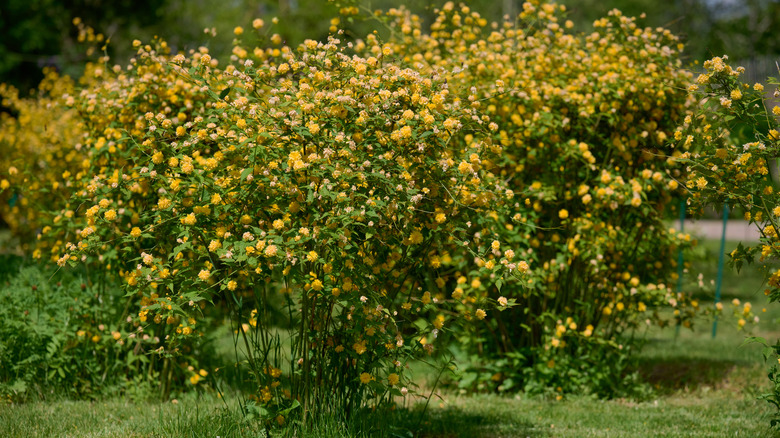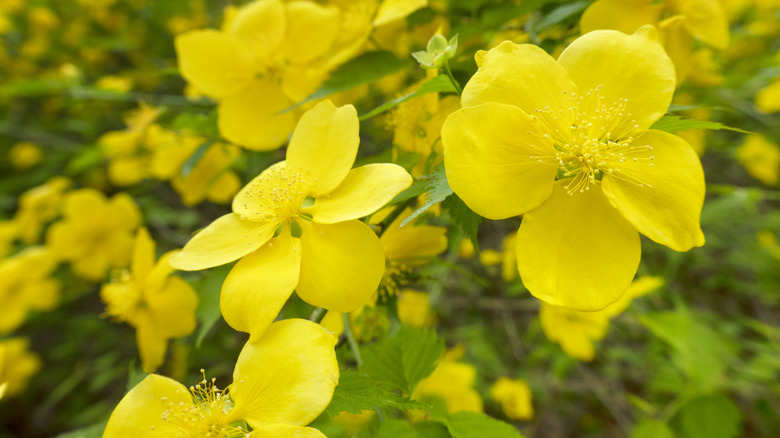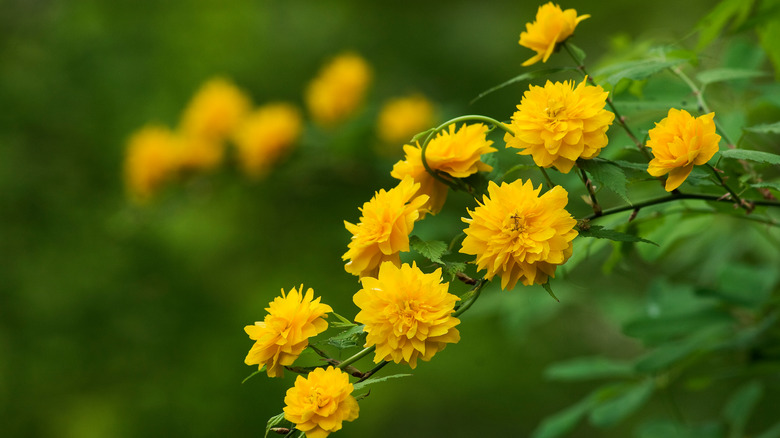Our Expert Gardener Suggests This Yellow Shrub As A Forsythia Alternative For Smaller Gardens
Forsythia is a well-loved flowering shrub you can grow in your yard for a colorful spring. But it can easily become very large and overgrown, and may become difficult to control in the garden if you don't have plenty of space for it. It also grows vigorously throughout the season, requiring frequent pruning if there isn't room for it to spread out. Fortunately, there is a much more manageable shrub that provides lovely bright yellow flowers in the spring and is much more suitable than forsythia for smaller gardens: Kerria japonica.
I've had a number of clients eager to plant forsythia, because the cheery yellow flowers remind them of spring memories of childhood. I've also had clients who regretted planting forsythia in their gardens, thinking it would stay compact and controlled, not knowing the shrub would get quite so large and unwieldy. I've had to dig out large overgrown forsythia shrubs and it's no easy task. I've also had to prune and trim overgrown, neglected forsythia and they can develop galls on their branches which have to be removed.
If you want a shrub that gives you bright yellow flowers in the spring but is easy to maintain and won't get too overgrown, try Kerria japonica. Its stems are green, not woody like forsythia. And although it grows larger over time, it can be pruned to a manageable size. This little-known shrub makes a great alternative to forsythia in your garden.
Planting Kerria japonica
Also known as Japanese rose, Easter rose, or Japanese kerria, this deciduous shrub (hardy to USDA growing zones 4-9), is very popular in gardens in Japan. Unlike forsythia, which needs sun to bloom, it flowers in shade, so it's also a good alternative for gardeners who don't have a lot of sun. The stems are evergreen, making this shrub a wonderful focal point in the winter garden.
The Kerria japonica has either single or double flowers, depending on the cultivar variety. The double-flowered varieties (like Pleniflora) have blooms resembling small pom-poms, with a golden yellow color. The single-flowering varieties (like Golden Guinea) are, to my eye, a bit more lemon-yellow in color, similar to forsythia. The bright yellow flowers that appear in profusion every spring make it a great choice for shade gardens, as the bright flowers will light up a shady space. It is also deer-resistant, so you don't have to worry about locating it in a woodland garden area.
This shrub likes a well-drained soil. Adding some loamy soil and compost when you plant will give it a good start. Avoid planting it in clay soil. Too much sun exposure can cause the flower color to fade, so make sure your Kerria japonica gets some shade during the day, especially in the afternoon if possible. This plant is fairly drought tolerant, but putting down a light layer of natural mulch helps conserve moisture around the roots.
Caring for Kerria japonica
Caring for Kerria japonica is fairly easy. There are two things to make sure you do regularly: prune the branches, and remove any suckers that appear at the base of the plant. The flowers bloom on the previous year's wood, so pruning should be done in the spring after flowering is finished. Removing suckers helps keep this shrub healthy and compact, and gives it a more upright fountain shape.
The mature size of a Kerria japonica is between 5 and 10 feet tall and wide, so it needs a bit of space, but if kept pruned, it can easily be made to fit into a smaller space. You can shape the shrub when you prune it in spring, to give it a more rounded shape. Regular pruning will also encourage more bud formation for the following year. Some gardeners like to place the Kerria japonica between other flowering shrubs, as it blooms early, and is then cut back to let other shrubs shine in the summer and beyond.
Kerria japonica is mostly disease and pest-free, with no known insect predators. However, it can sometimes be affected by a fungal disease known as twig and leaf blight. This can be treated with fungicide or by removing the affected stems. This shrub has no wildlife pests, and it may attract birds in winter seeking a bit of shelter in its twiggy green branches.


